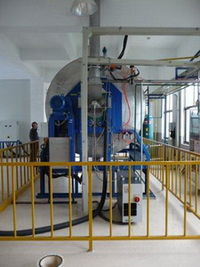Heated Mixers
Heated Mixers are used for metering & mixing of liquid, adhesives, processing unfilled cast urethane elastomers, vinyl esters, polyesters & abrasive-filled & unfilled epoxies. These are also mostly used in enhancing product characteristics of special compounds such as kneaders for producing (plastic) compounds. These special compounds can be used, for example, in isolation of high-voltage cables (110 kV, 220 kV) for power transmission. In the process of producing special HDPE and LDPE compounds, the heated mixer with heated mixing drum, is used for soaking the granulate with a special liquid. Also while mixing, the heated liquid is being sprayed onto the granulate, which enables the materials to gain the required characteristics within a defined conversion time.
Processes
Heated mixer ensures that the product keeps a stable temperature during the soaking and conversion process. The product is heated in the rotating mixing drum by hot water flowing through the double drum wall. The rotating water circuit is connected by a special rotary joint with the stationary water supply/discharge system. The injection lance for dosing the liquid (org. peroxide) is also jacketed and also heated with warm water. Because the peroxide is solid when cold, it is supplied in a hot liquid form to the injection system. The heated injection lance ensures the peroxide remains liquid and can be sprayed on to the granulate. The extreme purity specifications of this product (‘contamination’ << 1p.p.m.) forced a redesign of the drum seals. Already the slightest seal wear would already cause an unacceptable level of contamination. Therefore the seals have now been designed in a way that there is no contact between the rotating and stationary components. The mixer is also equipped with an inlet and outlet which can be retracted from the mixing drum over linear guides. This simplifies and speeds up intensive cleaning and inspection significantly.
Video
